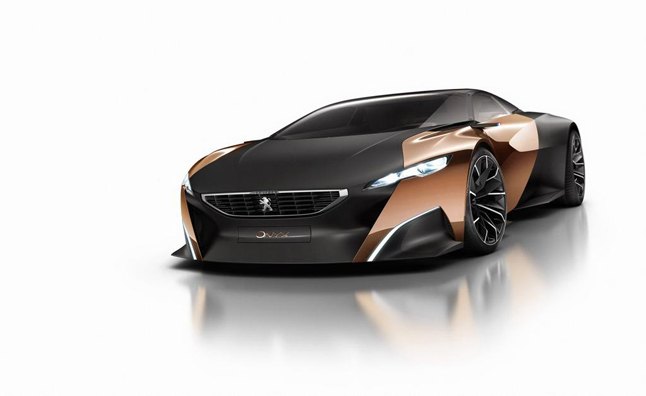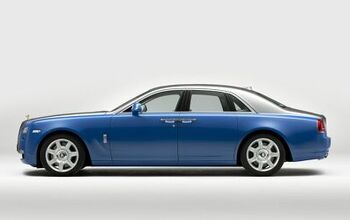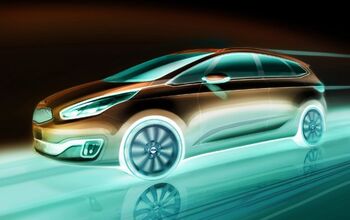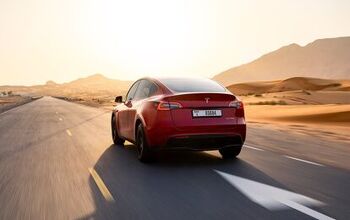Ten Paris Motor Show Reveals Worth Remembering

It’s the time of year when automakers go on a wonderful vacation to Paris and show off the latest and greatest vehicles. The Paris Motor show is here, and there are quite a few vehicles that are slated to be revealed this year.
Since the show comes around every-other year, some automakers use it as a great excuse to show off the latest concepts and production vehicles. This years show features a ton of great looking vehicles like Peugeot’s Onyx Supercar concept (seen above.)
Here’s our list of the Ten Paris Motor Show reveals from the past few years that are worth a look back on.
Check out AutoGuide’s coverage of the 2012 Paris Motor show here.
When Volkswagen first showed the IROC concept at the 2006 Paris Motor Show, the automotive world collectively dropped its jaws for the sexy hatchback. Of course, rumors about VW bringing back the Scirocco nameplate swirled around for quite a while before the IROC concept arrived, but it surprised everyone with it’s distinct style. The transformation from the IROC concept to the production Scirocco didn’t lose much in terms of exterior design, but the interior clearly lost much of it’s concept flare.
The IROC concept allowed VW to let down its hair in true Volkswagen fashion. Even for a concept, the IROC still keeps many of the design cues that make a VW, like the unmistakably simple and clean looking rear-end. Six years later, the Scirocco’s look is fresh and sexy. American buyers are still waiting for the Scirocco to jump overseas, especially sportier models like the 261-hp Scirocco R.
The Mazda Kiyora concept was first shown at the 2008 Paris Motor Show, and features a strong visual resemblance to the current Mazda3. That’s an interesting thought because the Kiyora was originally supposed to replace the sub-compact Mazda2. In terms of technology, the Kiyora concept features a 1.3L “SKY-G” engine and “SKY-Drive” six-speed transmission to provide a drive that’s easy on gas.
The Kiyora concept is influenced by water, which gives it the fluidic exterior design. Inside, the Kiyora looks downright crazy with sweeping lines flowing from all over the cabin, and a u-shaped steering wheel. Clearly the Kiyora is a design concept, since it features no visible dash, or usable buttons.
The Kiyora’s technology and style has certainly foreshadowed the latest Mazda vehicles. Mazda’s new SkyActiv-G engines have utilized the same lightweight design with an emphasis on delivering a car that’s fun to drive and fuel-efficient. The concept is also lightweight like many of Mazda’s new SkyActiv vehicles, and also features a start-stop system that uses a battery powered by regenerative brakes.
This Kia Pop EV was first shown at the 2010 Paris Motor show, and was influenced by specific items outside the realm of automotive design. You can spot the high-speed bicycle influence in the simplistic wheel design, and the unique doors that make the car look like it’s ready to take off.
Since this is a concept car, the Kia team dreamed up some incredible stuff for the Pop, like the dot-patterned lights, the back-lit front grille, and the full length glass roof. Once you get over the purple interior in the Pop, the vehicle sports a transparent organic LED panel for speedometer and battery charge gauges, while traditional buttons and dials are replaced by a single touch screen. All this means that the Pop features no traditional dash.
The concept also features an all-electric drivetrain which uses a 18 kWh lithium polymer gel battery with 67 horsepower and 140 lb-ft. This gives it an estimated range of 100 miles, and a top speed of 87 mph. This unique vehicle certainly deserves a spot on this top-ten thanks to it’s high-tech look and features.
The Audi quattro concept is a vehicle that celebrates 30 years of the Audi quattro four wheel drive system. The Concept also commemorates the thirtieth anniversary of the Audi Quattro’s debut at the 1980 Paris Motor Show. The concept shown off at the 2010 Paris Motor Show points back to Audi’s heritage in its five-cylinder engine and proven all-wheel drive system.
That five-cylinder engine puts out an astonishing 408 hp thanks to turbocharging, and this allows the vehicle to sprint to 60 mph in 3.9 seconds. The concept is actually based on an Audi RS5, but in the process of shortening the wheelbase, loses the rear-seats. Still, inside you’ll find a typically clean and luxurious Audi interior, and the vehicles’s infotainment system can be set up to provide track notes when racing a rally.
The Quattro concept paints the picture of a true sports car, with it’s tiny engine, and light-weight construction. At 2,866.01 lbs, this concept is more than 400 lbs lighter than even the Audi TT RS. This gives the vehicle a power-to-weight ratio comparable to the V10 equipped R8 supercar. While the Quattro concept was supposed to lead to a production vehicle, the idea was shelved.
When the Estoque concept was revealed at the 2008 Paris Motor Show, it painted a picture of a friendlier, more accessible Lamborghini. The four-door sedan was touted as the first front-engined vehicle since the LM002 SUV from the 80s. Additionally, with four-doors, the Estoque piqued the interest of exotic car fans with families.
The Estoque was originally supposed to lead to a production vehicle with a price tag of about $230,000, but sadly, the idea never materialized. Instead Lamborghini is looking to the Urus SUV to become the family hauler that the brand believes it needs.
The Estoque name, in traditional Lamborghini way is linked with bullfighting. Estoque is the Spanish word that refers to the traditional sword worn by a matador.
At the 2010 Paris Motor Show, Lotus showed off four concepts, but none were quite as eye-catching as the Esprit.
The Esprit sports a superb looking front-end that has a space-ship like look thanks to its sharp lines and LED front daytime running lights. Around back you’ll see a center-mounted dual exhaust system. As with every other Lotus, the Esprit has a focus on light-weight and uses carbon fiber nearly everywhere, including the interior. Weight is expected to be about 3,300 lbs, making it still a little chunky for a Lotus.
A huge in-house V8-engine is likely the culprit for the added weight, and there is apparently some V6 engines on the way, and a hybrid version coming along too. The mid-engine Lotus is expected to run the 60 mph spring in 3.4 seconds and have a top speed of 205 mph, two stats that would make the Esprit one of the fastest production cars in the world.
It might not sound like much now, but the R8, when it was first revealed in 2006, set the world on fire. The R8 used many of the underpinnings of the Lamborghini Gallardo, and allowed the German automaker to have a vehicle to fight the Porsche 911.
The R8 showed off a ton of cool supercar tech, like aluminum construction, LED headlights, dry sump lubrication (derived from Audi’s LeMans cars) and Audi’s R tronic sequential-shift gearbox. Pair that with the 420 hp engine that’s placed right in the middle of the vehicle, and the R8 arrived with style and purpose to the supercar game.
Concepts are a great way to explore an automakers thoughts. At the 2010 Paris Motor Show, Jaguars mind was clearly firing on all cylinders. That’s no pun, as the C-X75 concept featured no cylinders at all. By using four-electric motors, to provide power to the C-X75’s four-wheels, the new Jag was showing Paris what sort of technology to expect from high-performance automakers.
In the concept, those four electric motors are recharged via a plug, or with the two diesel turbines in the middle of the car. However, with plans to release a production C-X75, Jaguar toned it down a bit. The limited run of production C-X75’s will feature two electric motors; one at each axle, and instead of diesel turbines, the car will find additional range via a turbocharged gas engine.
Still, Jaguar paints impressive performance numbers for the production model, with a sub-3 second 60 mph sprint, and a top speed of 200 mph. All this while still providing environmentally friendly gas consumption.
The Aston Martin One-77 was first, partially shown off at the 2008 Paris Motor Show and features a carbon-fiber monocoque chassis. The specialty of the One-77 continues with a handcrafted aluminum body, and the exclusive production run of 77 models.
The 7.3 liter V12 engine boasts 750 hp, and Aston Martin claims that is the most powerful naturally aspirated production engine in the world. Thanks to a revised transmission from the DB9 and the One-77’s relatively low weight, the Aston-Martin can hit 60 mph in 3.5 seconds.
The design of the One-77 is also a major point of the vehicle, with it gaining recognition and winning many awards.
It’s hard not to love the Sesto Elemento, which was first seen at the 2010 Paris Motor Show. It features all the Lamborghini stylish flair, and is made with an excessive amount of weight saving carbon fiber. The name actually means sixth element, referring to Carbon, and the usage of Carbon Fiber in the construction of the vehicle.
By using a 570-hp V10 engine, and with its 2,200 lbs weight, the Sesto Elemento is one of the fastest cars around with a 0-60 mph time of 2.5 seconds. It also looks absolutely phenomenal with every bit of sheetmetal serving a functional purpose.

Sami has an unquenchable thirst for car knowledge and has been at AutoGuide for the past six years. He has a degree in journalism and media studies from the University of Guelph-Humber in Toronto and has won multiple journalism awards from the Automotive Journalist Association of Canada. Sami is also on the jury for the World Car Awards.
More by Sami Haj-Assaad










































Comments
Join the conversation